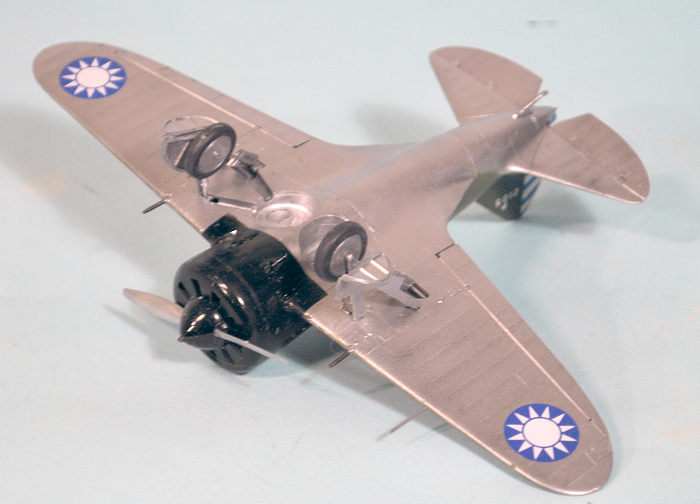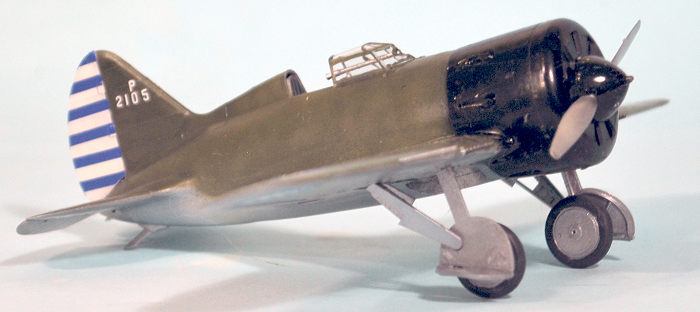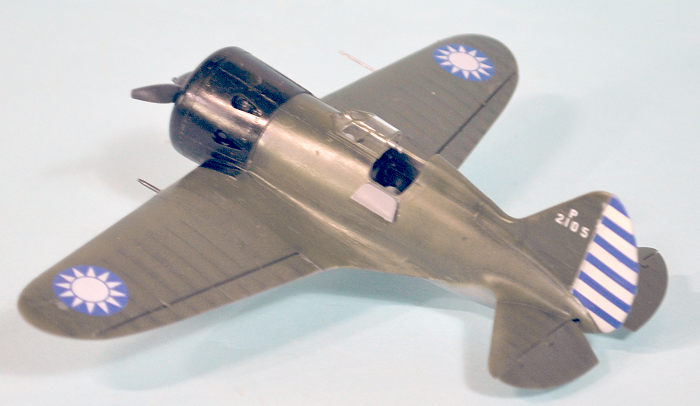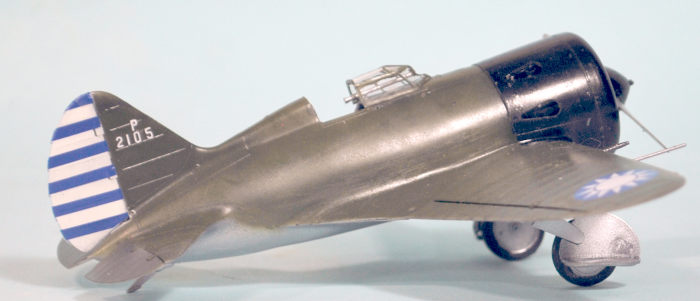
| KIT #: | |
| PRICE: | |
| DECALS: | Two options |
| REVIEWER: | Tom Cleaver |
| NOTES: |

| HISTORY |
Nikolai Polikarpov was perhaps the leading Russian aircraft designer in the early days of the Soviet aircraft industry. In 1918, he was put in charge of preparing manufacture of the DH-4 at the GAZ-1 facility where at least 63 were completed. Focus then switched to the DH-9A; Polikarpov headed the team charged with adapting the type for local production as the R-1, which became the first mass-produced soviet warplane.
By 1930, Soviet aircraft design in particular had made great strides. The Air Force's scientific research institute (the NII V-VS) was producing outlines for the future of combat aircraft. Few people in the west at that time realized just how advanced things were aeronautically in the USSR. With the powerplants and construction of the time, superior speed could be gained from a monoplane yet biplanes were clearly more maneuverable. The solution prescribed by the NII was a mixed fighter force of fast monoplanes and agile biplanes.
Polikarpov and his team designed the I-5 in 1930 while imprisoned by the NKVD on a charge of “sabotage;” the design's success led to their release. The I-5 led to the I-15 series that culminated in the I-153, the last monoplane fighter ordered into production by an air force in 1938.
 In 1931, A. N. Tupelov was assigned the task of designing the new
monoplane fighter, since the Tupolev Bureau had extensive experience of
monoplane design. Pavel Sukhoi was put in charge of design and the result was
the I-14, which flew in early 1933 - an all metal cantilever monoplane with
retractable undercarriage. This was at a time when the RAF was celebrating
adoption of the Hawker Fury biplane; the USAAC adopted Boeing's P-26, with
external bracing and fixed gear, as its first monoplane fighter; and the Armee
de l'Air adopted the D.500 with cantilever wings and fixed gear.
In 1931, A. N. Tupelov was assigned the task of designing the new
monoplane fighter, since the Tupolev Bureau had extensive experience of
monoplane design. Pavel Sukhoi was put in charge of design and the result was
the I-14, which flew in early 1933 - an all metal cantilever monoplane with
retractable undercarriage. This was at a time when the RAF was celebrating
adoption of the Hawker Fury biplane; the USAAC adopted Boeing's P-26, with
external bracing and fixed gear, as its first monoplane fighter; and the Armee
de l'Air adopted the D.500 with cantilever wings and fixed gear.
Meanwhile, Polikarpov sought permission to design a rival to the I-14. Design work on his new monoplane fighter, the TsKB-12, commenced in March 1933, In December the all-red prototype first flew with Valery P. Chkalov at the controls. The I-14 had flown eight months earlier but there were several problems, including slow recovery from spins. Work on the I-14 was discontinued after 22 had been built.
Polikarpov's new monoplane was of mixed construction. The fuselage was a monocoque made up of glued birch laths laid up over a basic four longeron frame with 11 stations. The completed wooden shell was covered with a madapolan type fabric for strength and sealing. The wing had a chrome-molybdenum steel tube truss-type center section, skinned in aluminum, while the outer wings had steel tube truss-type spars with steel sheet webs, and aluminum ribs, being covered in aluminum and fabric. The ailerons were also aluminum covered with fabric; with no flaps, these drooped 15 degrees for approach and landing. The tail surfaces were also fabric covered aluminum. The undercarriage retracted inwards through a complex series of cables and pulleys, all operated from the cockpit by manual winding. The cockpit was fully enclosed, with a canopy sliding forward for entry; this proved unpopular with pilots and was later replaced by a simple windscreen.
While the I-16 was thought in the west to be a copy of the Boeing P-26, that was not the case. In the early 1930s, high speed aerodynamics were little understood and if the I-16 shared anything in common with any American designs, it would have been American race planes such as the Gee Bee or the Turner Meteor, with its short-coupled design - at the time the only way a designer knew to create speed. The I-16 additionally shared difficult flying characteristics not all that different from its American racer cousins - an American pilot who flew it in combat in Spain said that a pilot couldn't take his attention off flying it for an instant without getting into trouble.
 Armed with two unsynchronized 7.62mm ShKAS machine guns in the wings,
which provided twice the rate of fire of any other aircraft machine gun in the
world, the I-16 attained 224 mph at sea level and was supremely maneuverable for
a monoplane. Deliveries of the I-16 Type 1 to the V-VS began in the late summer
of 1934; it was displayed publicly for the first time at the 1935 May Day
Parade, with several formations flown over Red Square. At this time, the RAF had
yet to order the Gloster Gladiator into production, and the Luftwaffe was only
beginning to take delivery of the Heinkel He-51, while the Dewoitine D.500 had
only just entered service with the Armee de l'Air. Even with this public
display, the I-16 roused no interest by Western aviation authorities, even after
large numbers took part in the large-scale autumn maneuvers held outside Kiev
that year, an event attended by Western military attaches.
Armed with two unsynchronized 7.62mm ShKAS machine guns in the wings,
which provided twice the rate of fire of any other aircraft machine gun in the
world, the I-16 attained 224 mph at sea level and was supremely maneuverable for
a monoplane. Deliveries of the I-16 Type 1 to the V-VS began in the late summer
of 1934; it was displayed publicly for the first time at the 1935 May Day
Parade, with several formations flown over Red Square. At this time, the RAF had
yet to order the Gloster Gladiator into production, and the Luftwaffe was only
beginning to take delivery of the Heinkel He-51, while the Dewoitine D.500 had
only just entered service with the Armee de l'Air. Even with this public
display, the I-16 roused no interest by Western aviation authorities, even after
large numbers took part in the large-scale autumn maneuvers held outside Kiev
that year, an event attended by Western military attaches.
In February 1934, the I-16 flew with an M-25 engine - the license-built version of the Curtiss-Wright Cyclone 9 - which had 50 percent more power than the M-22, and raised the I-16's top speed from 224 to 282 mph. The I-16 Type 5, which appeared in late 1935, adopted this powerplant for production.
The I-16 was approaching obsolescence by 1938, though it was flown by both Soviet volunteers and ROCAF pilots in China, where the I-16 pilots made the same fatal decision to dogfight IJNAF pilots in A5Ms that their Western counterparts did against similar highly-trained pilots in A6Ms four years later. It was outperformed by both the Ki.27 and A6M2, though the lower quality of JAAF pilots meant the Soviet pilots could meet them on more equal conditions, Later versions of the I-16 held their own against the JAAF in the air battles of the Nomonhan Incident.
| THE KIT |
 This Clear Prop release is the only early I-16 kit in 1/48 (they have
also released one in 1/72). The Eduard I-16 is a Type 10, the first with 4-gun
armament, and others are the later versions. Other releases are a Spanish Civil
War airplane and a Red Air Force airplane.
This Clear Prop release is the only early I-16 kit in 1/48 (they have
also released one in 1/72). The Eduard I-16 is a Type 10, the first with 4-gun
armament, and others are the later versions. Other releases are a Spanish Civil
War airplane and a Red Air Force airplane.
The kit is sharply molded and while it has a minimum of prts, a number of those are quite small, like the individual exhausts, each with a separate mounting piece. The result is this is the most detailed I-16 among the 1/48 options.
Decals are for two aircraft flown in the defense of Hankow in 1938 - one by a ROCAF pilot and one flown by Soviet Volunteers.
| CONSTRUCTION |
 The best thing to do is follow the well-done instruction booklet. Due to
the close tolerances of the parts, be sure all sprue nubs are removed from
mating surfaces. I began with the cockpit, where my only variation from what was
included in the box was to use an Eduard “Look” instrument panel and photoetch
seatbelts, primarily because I had that for review. The instrument panel is
really nice, but once in the cockpit it is very hard to see.
The best thing to do is follow the well-done instruction booklet. Due to
the close tolerances of the parts, be sure all sprue nubs are removed from
mating surfaces. I began with the cockpit, where my only variation from what was
included in the box was to use an Eduard “Look” instrument panel and photoetch
seatbelts, primarily because I had that for review. The instrument panel is
really nice, but once in the cockpit it is very hard to see.
Once the fuselage was assembled, I turned top the wing, which is three parts lower and two parts upper. Fabric surface detail is nicely restrained. I then attached the horizontal stabilizers and then the rudder, elevators and ailerons, which are all separate.
| COLORS & MARKINGS |
 I used Tamiya “Mica Silver” for the lower surfaces
and landing gear, and Mr Color 123 “RLM 80 Dark Green” for the upper surfaces, a
good approximation of Russian dark green. The engine cowling was painted with
Tamiya X-18 “Semigloss Black,” and the rudder was Tamiya X-2 Gloss White.
I used Tamiya “Mica Silver” for the lower surfaces
and landing gear, and Mr Color 123 “RLM 80 Dark Green” for the upper surfaces, a
good approximation of Russian dark green. The engine cowling was painted with
Tamiya X-18 “Semigloss Black,” and the rudder was Tamiya X-2 Gloss White.
I used the decal options for the ROCAF airplane. They went down without difficulty with Micro-Sol.
The landing gear is delicate and fiddly, but I assembled it without breaking anything. I positioned the sliding cockpit hood in the forward position, and then attached the prop.
| CONCLUSIONS |
Clear Prop’s production design is excellent. Surface detail is restrained and realistic. The result is the nicest, most accurate I-16 kit I have come across.
Thanks to Clear Prop for the review kit.
Tom Cleaver
23 August 2024
Copyright ModelingMadness.com. All rights reserved. No
reproduction in part or in whole without express permission from the editor.
If you would like your product reviewed fairly and
fairly quickly, please
contact
the editor
or see other details in the
Note to
Contributors.